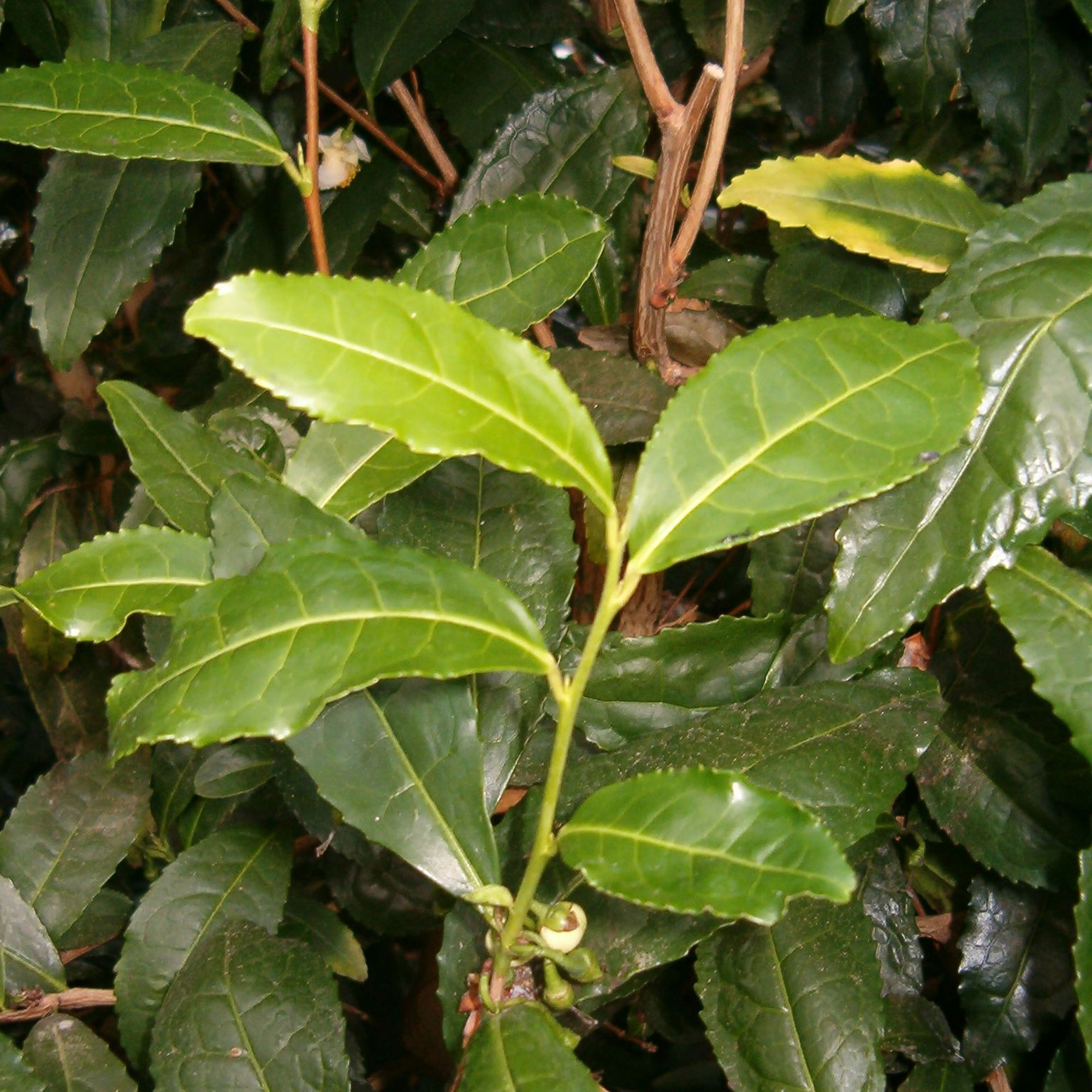Overview
Camellia sinensis is the evergreen shrub behind some of the world’s most beloved beverages: green tea, black tea, white tea, and oolong all come from its leaves. Native to East Asia, this versatile plant thrives in mountainous, misty regions and has been cultivated for thousands of years for both cultural ritual and daily refreshment. Its glossy green leaves and delicate white flowers belie a powerhouse of natural chemistry, offering a rich tradition of enjoyment, reflection, and wellbeing in every cup.
Common Name
Family
Genus
Species
Hardiness zone
Status

Parts Used

System Affinity

Preparation Method

Therapeutic Dosage

Tissue States

Energetics

Taste

Safety Class
Traditional Uses
Camellia sinensis has been revered for millennia in traditional systems of medicine, particularly in China, India, and Japan, where it has been used both as a daily beverage and a therapeutic remedy. In Traditional Chinese Medicine (TCM), green tea is said to clear heat, resolve toxins, stimulate digestion, lift the spirit, and dissipate phlegm—reflecting its use for mental clarity, fatigue, headaches, and longevity (Wang et al., 2022).
In Ayurveda, different preparations of the leaves have been used to kindle agni (digestive fire), support alertness, and promote elimination. Black tea was often chosen for warming and stimulating effects, while green tea was preferred to balance excess pitta and kapha dosha.
Across cultures, Camellia sinensis was valued for its astringent, bitter, and stimulating properties—applied to concerns like diarrhea, poor concentration, low energy, and sluggish digestion (Samanta, 2022). Externally, cooled infusions were sometimes used as eye compresses or soothing washes for inflamed skin.
Clinical Notes
Camellia sinensis offers broad clinical utility, particularly in cognitive support, metabolic regulation, cardiovascular resilience, and hepatic protection. Rich in catechins—especially EGCG—it exhibits potent antioxidant, anti-inflammatory, and thermogenic effects (Zhao et al., 2022; Samanta, 2022). These actions support its inclusion in protocols for insulin resistance, dyslipidaemia, and NAFLD.
Green tea catechins activate AMPK, reduce hepatic lipid accumulation, and improve endothelial function, lending value in managing type 2 diabetes, obesity, and cardiovascular risk (Brimson et al., 2022). Caffeine enhances alertness and mood, while L-theanine tempers overstimulation, promoting calm focus—especially helpful in stress-related cognitive fatigue (Ouyang et al., 2022).
With astringent and drying properties, C. sinensis suits tissue states of dampness or atony, including mild diarrhoea, weepy skin, or sluggish digestion. Topically, its antioxidant profile supports inflamed or irritated skin (Negah et al., 2021).
Neuroprotective and cardiometabolic benefits are further supported by emerging research. EGCG modulates oxidative stress, NF-κB and Nrf2 signalling, microglial activation, and apoptosis-related proteins (e.g. Bcl-2, caspase-3), with evidence of benefit in ischaemic stroke and neurodegenerative conditions such as Alzheimer’s and Parkinson’s disease (Ray et al., 2023; Li et al., 2024; Lin et al., 2022; Park et al., 2021).
In female reproductive disorders, EGCG has shown promise in improving ovarian function, regulating sex hormone levels, and supporting oocyte maturation—making it a candidate for use in polycystic ovarian syndrome (PCOS) and related metabolic conditions (Kamal et al., 2021; Zhao et al., 2021).
In male reproductive health, aqueous extracts of black tea have demonstrated improvements in sperm motility, mitochondrial activity, and membrane integrity—potentially supporting fertility outcomes in subfertile individuals (Setumo et al., 2023).
Caution is warranted in individuals with caffeine sensitivity, iron deficiency (due to reduced non-heme iron absorption), or stimulant use. Hepatotoxicity is rare but reported with high-dose extracts; whole-plant preparations are preferred for safety and synergy (Zhao et al., 2022).
Recent studies highlight the potential of Camellia sinensis in respiratory conditions such as allergic asthma and acute inflammatory lung disease. Green tea extracts have been shown to reduce airway inflammation, mucus hypersecretion, and key inflammatory mediators (IL-1β, IL-6, COX-2, NF-κB, MMP-9), supporting their use as adjuncts in managing asthma, ARDS, and allergic airway responses (Kang et al., 2023; Widowati et al., 2024; Pak et al., 2024; Rajizadeh et al., 2024).
Clinical and preclinical studies suggest Camellia sinensis may help maintain muscle mass and function, reduce oxidative stress post-exercise, and offer protective effects against age-related sarcopenia and osteoporosis. These effects appear to be mediated through antioxidant, anti-inflammatory, and mitochondrial-supporting mechanisms (Seo et al., 2021; Kulkarni et al., 2025; Tavares et al., 2022; Sivamaruthi et al., 2024).
Green tea may be used as a daily tonic in infusion form or more selectively via tincture or standardised extract depending on the clinical context.
Medicinal Actions

Nervous System

Endocrine & Hormonal System

Digestive System

Immune & inflammatory System

Reproductive System

Cardiovascular System

Respiratory System

Urinary System

Musculoskeletal & Tissue Repair

Metabolic & Regulatory

General / Systemic
Oncology Note
The anticancer activity of Camellia sinensis is largely attributed to its high content of epigallocatechin-3-gallate (EGCG), the most abundant and bioactive catechin in green tea. EGCG has demonstrated the ability to modulate multiple cancer-related pathways, including inhibition of tumour cell proliferation, angiogenesis, and metastasis; induction of apoptosis; and modulation of oxidative stress and immune responses. Recent research highlights EGCG’s capacity to target cancer hallmarks through mechanisms involving NF‑κB, PI3K/Akt, MDM2, HIF‑1α, and matrix metalloproteinases, with evidence of activity in cancers such as bladder, renal, and melanoma (Talib et al., 2024; Alam, 2024; Liu, 2025).
Contraindications
-
Caffeine sensitivity: May exacerbate anxiety, insomnia, palpitations, or hypertension in susceptible individuals. Use decaffeinated or low-caffeine preparations if needed.
-
Iron deficiency anaemia: Tannins can inhibit non-heme iron absorption; avoid concurrent intake with meals in iron-deficient patients.
-
Pregnancy and breastfeeding: Moderate intake (1–2 cups per day) is generally safe, but avoid concentrated extracts and high caffeine intake due to potential effects on fetal development and milk supply.
-
Hepatic conditions: High-dose green tea extracts (not whole tea) have been associated with rare cases of hepatotoxicity. Use with caution in patients with existing liver impairment; monitor liver function if used therapeutically.
-
Drug interactions:
-
May inhibit CYP3A4 and P-glycoprotein, potentially increasing plasma levels of medications such as statins, calcium channel blockers, and digoxin.
-
May induce CYP1A2, possibly reducing effectiveness of drugs like clozapine or theophylline.
-
Use caution with stimulant medications, beta-blockers, anticoagulants (e.g. warfarin), and MAOIs.
-
High-dose green tea extracts may interfere with catecholamine metabolism via COMT inhibition, affecting mood or blood pressure in sensitive individuals.
-
Therapeutic Indications

Nervous System

Endocrine & Hormonal System

Digestive System

Immune System

Reproductive & Sexual Health

Cardiovascular System

Respiratory System

Urinary System

Musculoskeletal System

Skin Wound & External

Pscyhological, Emotional & Energetic

Constitutional System & Multi System
Phytochemistry
1. Polyphenols
Flavanols (Catechins): Epigallocatechin gallate (EGCG), epigallocatechin (EGC), epicatechin gallate (ECG), epicatechin (EC)
→ Potent antioxidants; modulate inflammation; support cardiovascular, metabolic, and neurological health
→ EGCG is the most abundant and pharmacologically active catechin in green tea
Gallotannins and Theaflavins: Formed during oxidation (especially in black tea)
→ Astringent polyphenolic compounds; contribute to drying and toning actions; theaflavins exhibit antimicrobial and cholesterol-lowering effects
Phenolic acids: Gallic acid, chlorogenic acid
→ Contribute to antioxidant, anti-inflammatory, and hepatoprotective actions
2. Alkaloids
Caffeine
→ Central nervous system stimulant; increases alertness, enhances physical performance, improves reaction time
→ Synergistic with L-theanine to improve cognitive function without overstimulation
Theobromine, Theophylline
→ Bronchodilatory, diuretic, and vasodilatory effects; useful in respiratory support and circulation
3. Amino Acids
L-Theanine
→ Unique to tea; promotes relaxation without sedation, modulates dopamine and serotonin, balances stimulating effects of caffeine
4. Tannins
Hydrolyzable and condensed tannins (including gallotannins)
→ Contribute to astringency and digestive toning; may reduce iron absorption when consumed in high amounts
5. Saponins
Triterpenoid saponins
→ Mildly bitter; modulate immune responses, reduce inflammation, and may offer anti-tumour effects
6. Volatile Oils
Aromatic compounds including linalool, geraniol, and nerolidol
→ Contribute to the flavour profile of tea; exhibit mild antimicrobial and relaxing effects
7. Pigments and Carotenoids
Carotenoids: β-carotene, lutein, zeaxanthin
→ Act as antioxidants and support eye health; also influence leaf colour and nutritional value
8. Vitamins & Minerals
→ Contains B-complex vitamins (B1, B2, B3), vitamin C (notably in fresh green tea), and essential minerals such as manganese, potassium, magnesium, zinc, and fluoride
→ Fluoride contributes to dental health; manganese is important for enzymatic antioxidant systems
Pharmacokinetics & Related Drugs
-
CMAX / TMAX: EGCG reaches peak plasma concentration (TMAX) approximately 1.5–2 hours after ingestion. Bioavailability improves when taken on an empty stomach, but high doses may cause GI upset.
-
Excretion: Catechins and caffeine are primarily metabolised in the liver and excreted via the urine.
-
CYP450 Interactions:
-
CYP3A4: Mild inhibitor – may slow metabolism of certain pharmaceuticals (e.g. statins, benzodiazepines).
-
CYP1A2: Mild inducer – may increase clearance of caffeine, clozapine, and similar drugs.
-
CYP2C9: Possible weak inhibition – monitor in patients on warfarin, phenytoin.
-
-
Other Pathways:
-
Inhibits COMT, potentially increasing catecholamine activity (e.g. dopamine, norepinephrine).
-
Inhibits P-glycoprotein (P-gp) – may affect absorption of drugs like digoxin.
-
-
Conventional Analogues: Caffeine is structurally related to theophylline; EGCG exhibits anti-inflammatory and metabolic-modulating properties akin to some pharmaceutical agents.
References
- Alam, M. (2024). Epigallocatechin-3-gallate therapeutic potential in cancer. Biomed Research International, 2024, Article ID 10343677.
- Azami, S., & Forouzanfar, F. (2023). Therapeutic potentialities of green tea (Camellia sinensis) in ischemic stroke: biochemical and molecular evidence. Metabolic Brain Disease, 39(1), 347–357.
- Brimson, J. M., Prasanth, M. I., Kumaree, K. K., et al. (2022). Tea plant (Camellia sinensis): a current update on use in diabetes, obesity, and cardiovascular disease. Nutrients, 15(1), 37.
- Kamal, D. A. M., Salamt, N., Zaid, S. S. M., & Mokhtar, M. H. (2021). Beneficial effects of green tea catechins on female reproductive disorders: A review. Molecules, 26(9), 2675.
- Kang, S., Kim, H. Y., Lee, A. Y., Kim, H. S., Park, J. H., Moon, B. C., … & Seo, Y. S. (2023). Camellia sinensis (L.) Kuntze extract attenuates ovalbumin-induced allergic asthma by regulating airway inflammation and mucus hypersecretion. Pharmaceutics, 15(9), 2355.
- Kulkarni, C., Sadhukhan, S., & Chattopadhyay, N. (2025). Evaluation of antiosteoporosis effects of Camellia sinensis (tea), its extracts, and major compounds. In V. R. Preedy (Ed.), Tea in health and disease prevention (pp. 335–346). Academic Press.
- Li, S., Wang, Z., Liu, G., & Chen, M. (2024). Neurodegenerative diseases and catechins: (−)-epigallocatechin-3-gallate is a modulator of chronic neuroinflammation and oxidative stress. Frontiers in Nutrition, 11, 1425839.
- Lin, M. C., Liu, C. C., Lin, Y. C., & Hsu, C. W. (2022). Epigallocatechin gallate modulates essential elements, Zn/Cu ratio, hazardous metal, lipid peroxidation, and antioxidant activity in the brain cortex during cerebral ischemia. Antioxidants, 11(2), 396.
- Liu, H., Zhang, Y., Chen, M., & Xu, D. (2025). Network pharmacology and in vitro analyses reveal EGCG’s significant anticancer effects. Biochemical Pharmacology, 205, 115493.
- Negah, S. S., Ghazavi, H., Vafaee, F., Rashidi, R., Aminian, A. R., & Forouzanfar, F. (2021). The potential role of green tea and its main constituent (epigallocatechin-3-gallate) in pain relief: A mechanistic review. Current drug discovery technologies, 18(6), 21-27.
- Ouyang, J., Peng, Y., & Gong, Y. (2022). New perspectives on sleep regulation by tea: harmonizing pathological sleep and energy balance under stress. Foods, 11(23), 3930.
- Pak, S. W., Lee, I. S., Kim, W. I., Lee, S. J., Kim, J. C., Shin, I. S., & Kim, T. (2024). Camellia sinensis L. alleviates OVA-induced allergic asthma through NF-κB and MMP-9 pathways. Animal Cells and Systems, 28(1), 381–391.
- Park, D. J., Kang, J. B., Shah, M. A., & Koh, P. O. (2021). Epigallocatechin gallate alleviates down-regulation of thioredoxin in ischemic brain damage and glutamate-exposed neuron. Neurochemical Research, 46(11), 3035-3049.
- Rajizadeh, M. A., Najafipour, H., & Bejeshk, M. A. (2024). An updated comprehensive review of plants and herbal compounds with antiasthmatic effect. Evidence-Based Complementary and Alternative Medicine, 2024(1), 5373117.
- Ray, A., Mishra, R., & Jain, A. P. (2023). Therapeutic potentialities of green tea (Camellia sinensis) in ischemic stroke: biochemical and molecular evidence. Metabolic Brain Disease, 39, 347–357.
- Samanta, S. (2022). Potential bioactive components and health promotional benefits of tea (Camellia sinensis). Journal of the American Nutrition Association, 41(1), 65–93.
- Seo, H., Lee, S. H., Park, Y., Lee, H. S., Hong, J. S., Lim, C. Y., … & Hong, K. B. (2021). (−)-Epicatechin-enriched extract from Camellia sinensis improves regulation of muscle mass and function: Results from a randomized controlled trial. Antioxidants, 10(7), 1026.
- Setumo, M. A., Choma, S. S. R., Henkel, R., & Opuwari, C. S. (2023). Black tea aqueous extracts improve human sperm functions: An in vitro study. Andrologia, 2023(1), 4323458.
- Sivamaruthi, B. S., Sisubalan, N., Wang, S., Kesika, P., & Chaiyasut, C. (2024). Exploring the therapeutic potential of green tea (Camellia sinensis L.) in anti-aging: A comprehensive review of mechanisms and findings. Mini-Reviews in Medicinal Chemistry. Advance online publication.
- Talib, W. H., Abu-Darwish, M. S., Alhusban, A., & Alkhazaleh, M. (2024). Targeting cancer hallmarks with epigallocatechin gallate. Molecules, 29(6), 1373.
- Tavares, C. T., Lobo, A. C. S., Almeida, C. C. B., Lima-Silva, A. E., & Ferreira, S. M. R. (2022). Effectiveness of green tea extract (Camellia sinensis) capsule supplementation for post-exercise muscle recovery in healthy adults: A systematic review protocol. JBI Evidence Synthesis, 20(4), 1150–1157.
- Wang, C., Han, J., Pu, Y., & Wang, X. (2022). Tea (Camellia sinensis): a review of nutritional composition, potential applications, and Omics Research. Applied Sciences, 12(12), 5874.
- Widowati, W., Priyandoko, D., Lenny, L., Revika, R., Novianti, S., Kusuma, H. S. W., & Rizal, R. (2024). Camellia sinensis L. extract suppresses inflammation on acute respiratory distress syndrome cell models via decreasing IL-1β, IL-6 and COX-2 expressions. Trends in Sciences, 21(1), 7010–7010.
- Zhao, L., Sun, Q. Y., & Ge, Z. J. (2021). Potential role of tea extract in oocyte development. Food & Function, 12(21), 10311–10323.
- Zhao, T., Li, C., Wang, S., & Song, X. (2022). Green tea (Camellia sinensis): A review of its phytochemistry, pharmacology, and toxicology. Molecules, 27(12), 3909.

